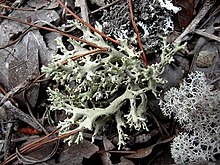Cladonia perforata
| Cladonia perforata | |
|---|---|
 |
|
| Scientific classification | |
| Kingdom: | Fungi |
| Division: | Ascomycota |
| Class: | Lecanoromycetes |
| Order: | Lecanorales |
| Family: | Cladoniaceae |
| Genus: | Cladonia |
| Species: | C. perforata |
| Binomial name | |
|
Cladonia perforata A.Evans (1952) |
|
Cladonia perforata is a rare species of lichen known by the common names Florida perforate cladonia and Florida perforate reindeer lichen. It is endemic to the state of Florida in the United States, where it is known from 16 populations in four widely separated areas of the state. It is native to a very specific type of Florida scrub habitat which is increasingly rare and patchy due to habitat destruction, degradation, and fragmentation. In 1993 this was the first species of lichen to be federally listed as an endangered species of the United States.
This lichen is relatively large, its yellow-gray, slightly glossy fruiting body measuring up to 6 centimeters (2.4 in) in length. The fruiting body, the visible part of the lichen, is a branching, tufted structure. The branches, or podetia, are lined with hyphae on their inner surfaces and are perforated with tiny holes. It and similar species undergo vegetative reproduction in which it clones by physically breaking up and spreading. No sexual reproduction has been observed. The lichen's method of biological dispersal is to have its fragments swept or blown to new locations.
In general, this species is poorly known. Little information is available about its life history, including its precise reproductive cycle, growth, population dynamics, or any seasonal changes it might experience.
The habitat of this species is the white sand of the Florida scrub, already a rare and endangered type of ecosystem, and the lichen requires a specific spot within the habitat. It can be found on high dunes and ridges among sand pines (Pinus clausa) in the part of the scrub understory called "rosemary balds": land dominated by Florida rosemary (Ceratiola ericoides). The lichen occurs in very dry, open sites on sand with little plant cover around it. It can often be found tangled up in clumps with other species of lichen.
...
Wikipedia

